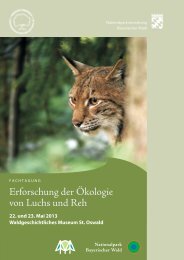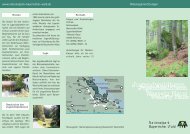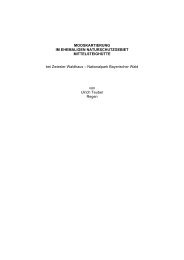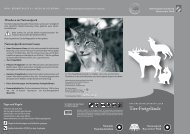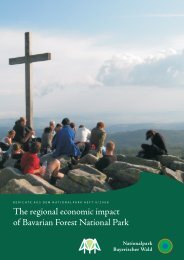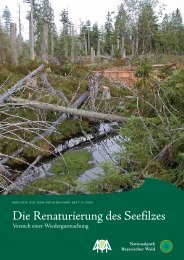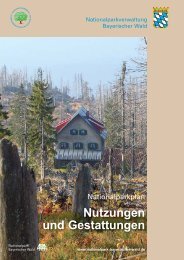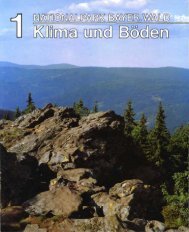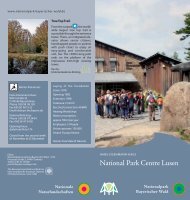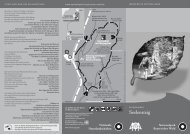Preparation of the National Park Plan - Nationalpark Bayerischer Wald
Preparation of the National Park Plan - Nationalpark Bayerischer Wald
Preparation of the National Park Plan - Nationalpark Bayerischer Wald
You also want an ePaper? Increase the reach of your titles
YUMPU automatically turns print PDFs into web optimized ePapers that Google loves.
12 NATIONAL PARK PLAN 2010<br />
1.3. Conservation and reintroduction <strong>of</strong> native animal<br />
and plant species<br />
The large near-natural habitats in <strong>the</strong> national park are <strong>of</strong><br />
national and international importance for species protection.<br />
The national park places particular emphasis on <strong>the</strong><br />
preservation and reintroduction <strong>of</strong> <strong>the</strong> natural biological<br />
diversity. This happens to a great extent through <strong>the</strong> natural<br />
development <strong>of</strong> <strong>the</strong> ecosystem.<br />
In <strong>the</strong> course <strong>of</strong> history, settlement and use <strong>of</strong> <strong>the</strong> Bavarian<br />
Forest have permanently changed <strong>the</strong> animal and plant world.<br />
For example, ho<strong>of</strong>ed game animals currently have to be<br />
managed because <strong>of</strong> <strong>the</strong> lack <strong>of</strong> natural predators and disruptive<br />
environmental factors, (see Appendix ‘Schalenwildmanagement’).<br />
O<strong>the</strong>r species were deliberately eliminated or are now<br />
under serious threat because <strong>of</strong> changes to <strong>the</strong>ir habitats and<br />
o<strong>the</strong>r disturbances. In <strong>the</strong>se cases, supportive measures are<br />
required, in order to prevent a stark reduction in numbers or<br />
even complete disappearance from <strong>the</strong> region (see Appendix ‚<br />
Arten- und Biotopschutz ). The designation <strong>of</strong> peaceful zones<br />
(core areas with no access) supports <strong>the</strong>se species protection<br />
measures.<br />
The Höllbachgespreng and waterfall<br />
in <strong>the</strong> Falkenstein area have been<br />
a protected nature area since 1941<br />
(Photo: Hans Kiener)<br />
1.4. Preservation and Reestablishment <strong>of</strong> Natural,<br />
Unforested Habitats<br />
From a nature protection point <strong>of</strong> view, unforested habitats<br />
such as moors and areas <strong>of</strong> rock and water represent<br />
a significant enrichment <strong>of</strong> <strong>the</strong> diversity <strong>of</strong> habitats. An<br />
undisturbed development <strong>of</strong> <strong>the</strong>se naturally tree-free areas is<br />
also an objective. However for reasons <strong>of</strong> species and habitat<br />
protection, especially where <strong>the</strong>re has been human interference,<br />
positive measures can be necessary (see Appendix ‘Renaturierung<br />
/ Renaturalization’).<br />
Disruptive influences by visitors, in particular, need to be<br />
avoided in <strong>the</strong>se sensitive habitats. The direction <strong>of</strong> visitors<br />
should achieve <strong>the</strong> minimum <strong>of</strong> damage.



